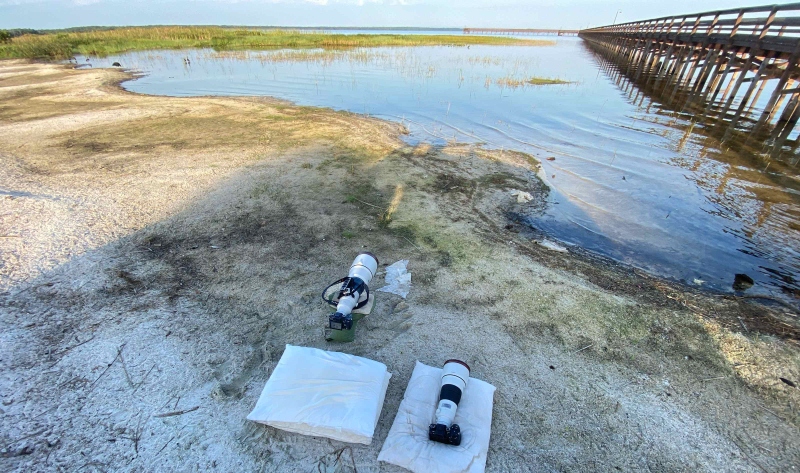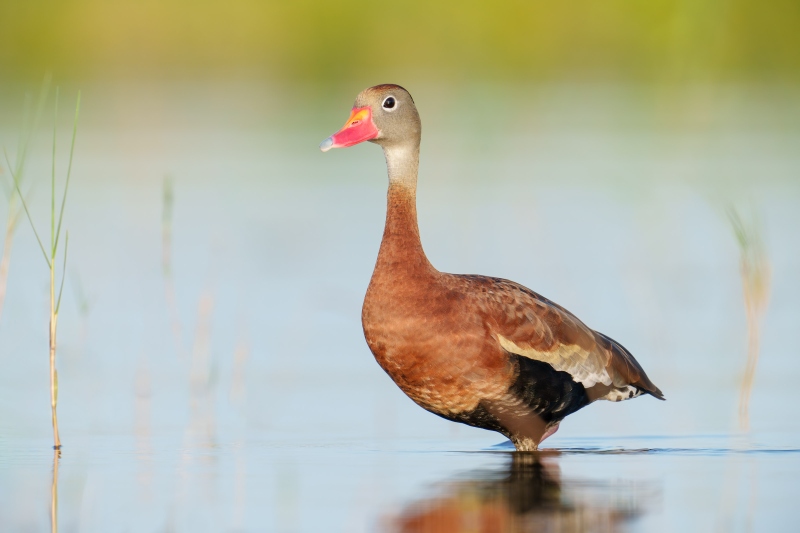|
|
Image #1: “Left of the pier down by the lake near my home” |
Left of the Pier
As many as three dozen whistling ducks along with two families of Limpkins and several other species have been providing excellent morning photography action in the tiny bay to the left of the pier. Each day, I have been trying something new. And the best news is that everything has been working. On Saturday past, I put the BLUBB right down on the ground and shot the 1200mm/a1 rig off of that. I made sure to turn off Direct Manual Focus (to prevent throwing off the focus) and was surprised to see how easy it was to frame the shots and follow slowly moving birds. When working off the rear screen, be sure to bring your reading glasses 🙂
For the Limpkin shots in the video below, I did work off a lowered tripod topped by a Levered-Clamp FlexShooter Pro. The levered-clamp makes it beyond easy to switch back and forth.
The biggest problem at this spot is that emerging grasses often obstruct the subjects.
Note the big lens balanced nicely on the BLUBB, the two pillows for me to sit on, and the 300mm f/2.8/1.4X TC/a9 iii rig on an extra pillow where it can be grabbed quickly as a duck flies in to join the party.
Picking My Keepers From an Exciting Morning Down By the Lake
Sit besid me as I pick my keepers from last Saturday morning. Learn why which images are best and why. Learn to see, evaluate, and use the light, and to choose the best perspective. And learn how to avoid or at least minimize the grasses!
Which of the 58 surviving images do you think are best? Which is your fave? Note: Well more than half of those will be deleted after the second edit.
As most of you know, blog post notifications quit working on 4 May. Best is to favorite www.BIRDSASART-Blog.com and visit every other day to avoid missing lots of great lessons.
|
|
|
This image was created on 25 May 2024 down by the lake near my home at Indian Lake Estates, FL. Seated on damp sand, my rig was supported by the BLUBB that I had placed on the ground. I was using the Sony FE 600mm f/4 GM OSS lens, the Sony FE 2.0x Teleconverter, and The One, the Sony Alpha 1 Mirrorless Digital Camera). The exposure was determined via Zebra technology with ISO on the thumb dial. ISO 2000. 1/1000 sec. at f/9 (stopped down 1/3-stop) in Manual mode. When evaluated in RawDigger, the raw file exposure was determined to be perfect. AWB at 7:30:00am on sunny morning. Tracking: Expand Spot/AF-C with Bird Face/Eye detection enabled performed perfectly even at 1200mm. Be sure to click on the image to enjoy a high-res version. Image #2: Black-bellied Whistling Duck between the grasses |
Bingo!
This one off the BLUBB features an ultra-low perspective. I like it best because the duck is perfectly framed by the usually distracting grasses.
If you would like to see more “Picking Your Keepers” video, please leave a comment.
Typos
With all blog posts, feel free to e-mail or to leave a comment regarding any typos or errors.
















Interesting video, though I’d never edit so tightly, given that post-processing and preferences can change over time. But your A9III “videos” got me curious enough to look up video frame rates. Normal cinematography rate is said to be 24 fps, whereas 60 or 120 fps would be used mostly for special effects (explosions, etc.) in action films. So the A9 III is really shooting high-end video, though I guess for only a few seconds at a time. (I knew nothing about video, having hit the record button on my cameras only by mistake–right next to ISO on an R7.)